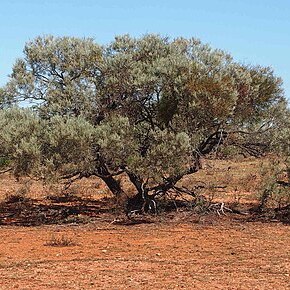Rounded shrub or straggly tree 3–5 m high, often many-stemmed from base; canopy spreading and bushy. New shoots resinous, bright green and often yellow appressed-puberulous. Branchlets apically hoary or silvery appressed-puberulous. Phyllodes variable, narrowly linear to linear-oblanceolate or very narrowly elliptic, straight to shallowly curved, 5–14 cm long,1–10 mm wide, normally ± uncinate, coriaceous, densely hoary or silvery appressed-puberulous, obscurely multistriate. Inflorescences 2–5-headed racemes; raceme axes normally 3–15 mm long, yellow or silvery appressed-puberulous; peduncles 2–8 mm long, with indumentum as on raceme axes; heads globular, 3–4 mm diam., 30–60-flowered, golden. Flowers 5-merous; sepals ± free. Pods ±moniliform, to 12 cm long, 4–8 mm wide, ± woody, wrinkled over seeds, appressed-puberulous. Seeds longitudinal, elliptic, 6–8 mm long, dull, khaki-brown; aril clavate.
More
A small shrub or tree. It often branches near the ground. The bark is thick and rough. The young shoots are yellow or bronze in colour. They are sticky. The leaves (phyllodes) are 5-11 cm long by 0.2-1 cm wide. They are often curved and silvery. They are marked with narrow lines or ridges. The end has a small hook. The flower heads are round and bright yellow. Often they are carried as single flowers but can also be in long flowers stalks up to 28 cm long. These flower stalks can also have there own leaves (phyllodes). The pods are long and thin (5-10 cm by 0.5-0.6 cm) and slightly curved. The pods are squeezed in between the seeds and are woody when mature.
Grows in heavy calcareous soils, often over limestone, along ephemeral watercourses and on degraded sand dunes, in low open woodland and tall open shrubland, often with members of the ‘Acacia aneura group’.
More
It occurs in inland Australia. It grows on calcareous or neutral soils. It is a very hardy plant.


